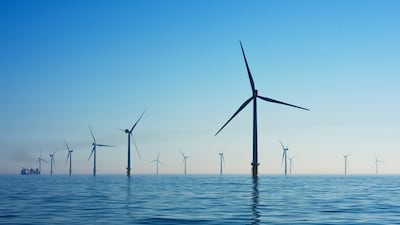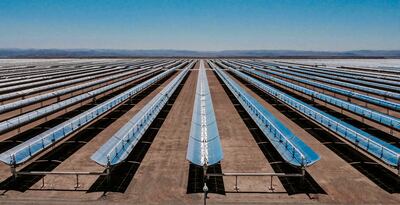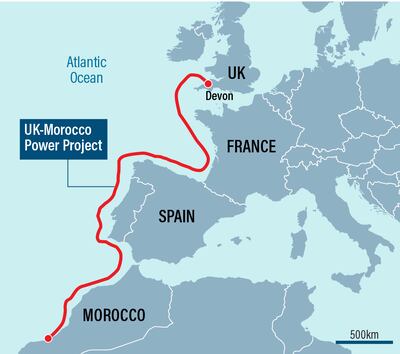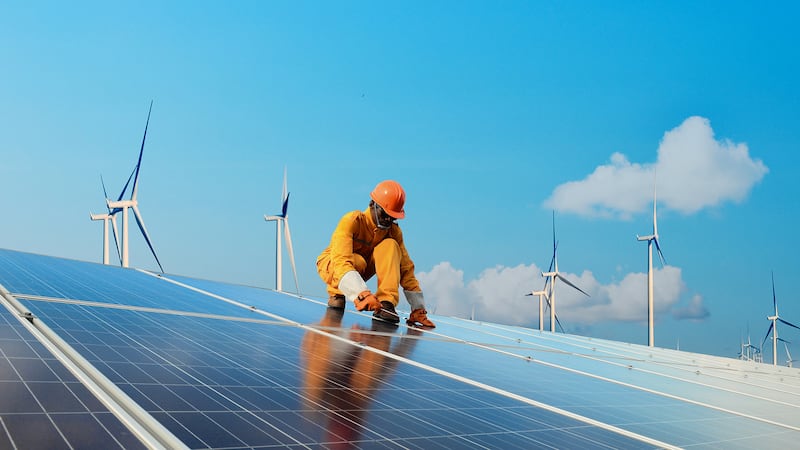On the face of it, a project to lay a cable to bring electricity from the sandy fringes of the Maghreb across the Atlantic to the south coast of the UK sounds like desperation in the teeth of an unprecedented energy crunch.
Long before the UK and its European neighbours were plunged into crisis by the shutdown of Russian gas pipelines, the idea was in gestation, as entrepreneurs sought to harness the power of the sun, catching it on Moroccan solar farms and moving the energy to the cooler climes of the British Isles.
That the concept is the brainchild of one of the country's top business figures gave it heft before household energy prices shot up three-fold.
Former Tesco chief executive Sir Dave Lewis announced grand plans to build the world’s longest undersea electric cable to transfer renewable power from Morocco directly to the UK national grid in 2018.
Now the firm Xlinks says its solar and wind farm as well as 15,000 kilometres of underwater cables will allow it to deliver enough electricity to power more than seven million British homes.
Launched weeks before the UK hosted Cop26 in Glasgow, Xlinks’ UK-Morocco Power Project sat proudly within Britain’s burgeoning clean energy ambitions.
But in today’s energy crisis-ridden Europe, Xlinks chief executive Simon Morrish tells The National the project has taken on an even more important role.
“Passion for the environment” and wanting to “help move the needle on climate change” were the primary reasons he cofounded the company, but Mr Morrish says the Russian invasion of Ukraine in February added more urgency to the development of renewables.

“Understanding the malevolent influence that [Russian President Vladimir] Putin has on Europe and his hold on our energy supplies” had long made the entrepreneur aware of the uncomfortable hold the world’s second-largest gas supplier had on end users.
Ofgem reported that the wholesale price of gas has increased 68 per cent since the war began in February, and by 266 per cent in the past 12 months.
“This only makes what we're doing here even more important and vital to get done quickly. The economics stacked up amazingly beforehand but now they're overwhelming,” says Mr Morrish.
Harnessing the sun’s energy may not be new — but being cheap enough to scale up and transfer across borders is.
Last year, the International Renewable Energy Agency (Irena) found that the cost of large-scale solar power had fallen by more than 85 per cent in less than a decade.
Renewables are now significantly undercutting fossil fuels as the world’s cheapest source of power and the current energy crisis looks set to widen that price differential further.
Countries such as Morocco, with an abundance of space and sun as well as an ambitious national strategy to become a global climate leader, are poised to capitalise on the renewed focus on clean energy.
Leading the drive for clean energy from the desert
Morocco's national action on climate change dates back to the mid-2000s, when the country made the decision to become a regional leader in clean energy and to push forward massive renewables projects.
In 2009, the North African nation set out an ambitious energy plan which aimed for 42 per cent of total installed power capacity to be renewable energy by 2020.
A number of large renewables projects were launched, including the Noor-Ouarzazate complex, the world's largest concentrated solar power plant.

Although Morocco its 2020 target by 5 per cent, it has since pledged to increase the renewables in its electricity mix to 52 per cent by 2030, made up of solar, wind and hydro.
The Xlinks project will lead to even more mirrors staring up at the sky above the Sahara, with a new power generation facility that comprises both a solar and wind farm on an area of 1,500 square kilometres in the Guelmim Oued Noun region.
The combined facility will generate 10.5 gigawatts of energy, of which 3.6 gigawatts is planned to be transmitted to the UK to meet up to 8 per cent of its electricity demand by 2030.
Xlinks says the £16 billion project is expected to generate 10,000 jobs in Morocco and 1,350 in the UK.

It is also in line with the British Energy Strategy announced by former prime minister Boris Johnson in April to push forward the government’s plans to decarbonise the electricity system by 2035 and become a net-zero consumer by 2050.
Having realised how “quickly dependence on foreign energy can hurt British families and businesses”, the government declared its intention to accelerate the transition away from oil and gas.
While offshore wind farms, including what will be the largest in the world when it is completed in Yorkshire next year, are part of the UK’s long-term shift to cleaner energy, there’s a need for other renewables sources.
Environmental scientist Jono Adams tells The National that the UK-Morocco project is a laudable example of how to take advantage of the significant solar and wind energy potential in a particular location.
“This is an important principle to apply to generation generally across the globe, to develop generation in the most effective manner,” says the director at global sustainability consultancy Anthesis.
Nevertheless, Mr Adams says that “just taking resources from the global south to use in the global north” does little to fix the underlining problem. The criticism echoes questions raised over the fairness of asking countries that are less industrialised to curtail their energy consumption so that industrialised nations can have their fill.
Power from the Sahara to Devon with world's longest subsea cables
Morocco’s natural resources generate three times more energy than those of the UK, and once complete, the project will be capable of supplying 8 per cent of Britain’s electricity needs.
But if generation was simple and cheap enough, the challenge came in figuring out how to store and transfer it.
Four rows of 3,800km, high-voltage direct current (HVDC) subsea cables is how.
Mr Morrish says it became quickly apparent to the British green energy company that demand for these cables was too high for existing to suppliers to meet their project’s requirements. So the team established another company: XLCC.
The HVDC subsea cable manufacturing operations will break ground on their first site in Hunterston, Scotland, in September with a view to producing their first cable in mid-2026.
However, battery capacity and converter stations are other crucial parts of the project that are in short supply.
Mr Morrish says they don’t have to install batteries until 2026, giving them “plenty of time to procure and build additional battery capacity”, but soaring worldwide demand for lithium — a key component in batteries — may create other sourcing issues.

Meanwhile, a physical subsea survey is already under way to see where the cables, which will dip inside the territorial waters of Spain, Portugal, and France before reaching the National Grid in Devon, will be laid.
Xlinks still has to get permissions from the European countries but Mr Morrish has a surprisingly “idealist” outlook about that.
“I just think, why would anybody not give a permit for this much renewable power to help the end? Would you would you want to be a country that stands in the way of such benefit to the environment?”
Britain’s renewables revolution
The company isn’t asking that much more of the UK government either. The project has been developed without subsidies and Mr Morrish says they aren't needed, insisting that “it’s up to business leaders” to come up with energy solutions.
But what Xlinks does need from the government is a guaranteed 25-year offtake of the energy produced, which Mr Morrish says the company is currently negotiating.
Britain’s ambitious plans for a five-fold increase in offshore wind by 2030 are well under way, with 42 offshore wind farms already in operation, providing 11 gigawatts of power and a further 93 in development or planning to provide 95 gigawatts.
If these projects make the UK-Morocco one seem redundant, Mr Morrish is quick to point out that despite the reputation of British weather, it isn’t always windy.
“Part of our negotiation with the UK government is to be able to provide for peak hours on 99 per cent of days,” he says.
“So if it's a cold, cold, February afternoon, when there's no wind in the UK and a grid under pressure, we will always be there. So that's supremely valuable to the UK grid.”
Mr Morrish says the impact on the underwater environment is “negligible”, likening the process to “ploughing a strip of a field” with a machine that will liquidise the seabed by pumping high pressure water to allow the cables to sink down into a safe enclosure.
While no one is relishing cutting down on their energy use, soaring prices have forced a reckoning that Mr Adams, like many others, says is needed to reverse climate damage.
“For net zero to be achieved, we need to decrease energy consumption alongside increasing our use of renewables,” says Mr Adams.







